Colchicine Induced Model
Colchicine can selectively destroy hippocampal pyramidal cells and granulosa cells, resulting in cholinergic system damage and short-term learning and memory impairment. Generally, we can induce dementia by injecting colchicine into the ventricles of rats.
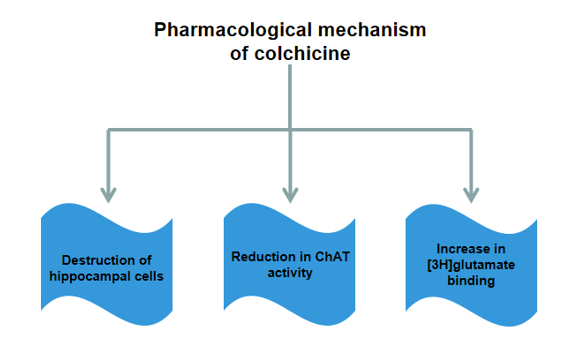 Figure. 1. Pharmacological mechanism of colchicine-induced Alzheimer's disease model
Figure. 1. Pharmacological mechanism of colchicine-induced Alzheimer's disease model
Our capabilities
- We can provide comprehensive behavioral and cognitive testing on AD model and the drug screening.
- We can evaluate anti-oxidative stress in the hippocampus of animals treated with drug candidates.
- We can evaluate various biomarkers through WB, IHC, ELISA, sequencing, etc.
Assays available
- Learning and memory deficits tests
- Oxidative stress
- Neuroinflammation
- Phosphorylated tau
- Glycogen synthase kinase-3 beta (GSK3β)
- Neurofilament Light Chain levels
- Enzyme activity related to cholinergic system
- Mitochondrial dysfunction
- Brain slice staining and synaptic electrophysiology
With 10 years of hard working and continuous development, as a senior leader specialize in AD research with enormous industrial experience, Creative Bioarray is exceptionally positioned to be your partner. We will make our best efforts to meet your unique requires by providing individually customized service.
Study examples
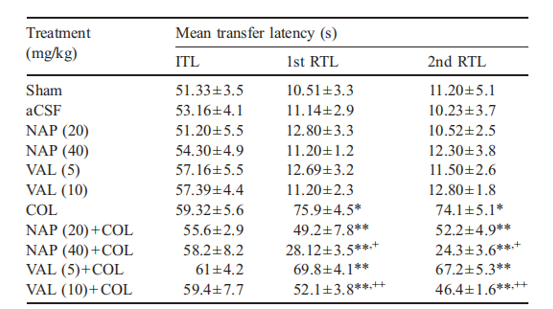 Figure. 2. Effect of cyclooxygenase inhibitors on elevated plus maze performance task in colchicines-treated rats
Figure. 2. Effect of cyclooxygenase inhibitors on elevated plus maze performance task in colchicines-treated rats
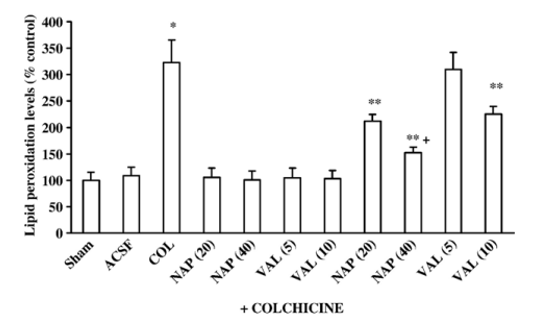 Figure. 3. Effect of cyclooxygenase inhibitors (naproxen (NAP) 20 and 40 mg/kg, p.o. and valdecoxib (VAL) 5 and 10 mg/kg, p.o.) on brain lipid peroxidation levels in intracerebroventricular colchicine (COL)-injected rats. Values are mean ± S.E.M. * P<0.05 as compared to artificial cerebrospinal fluid (aCSF)- injected group; ** P<0.05 as compared to colchicine-injected group; **+ P<0.05 as compared to NAP (20) +COL group. (Repeated measures twoway ANOVA followed by Tukey's test for multiple comparisons). Note: aSCF = artificial cerebrospinal fluid, NAP = Naproxan, COL = Colchicine, VAL = Valdecoxib.
Figure. 3. Effect of cyclooxygenase inhibitors (naproxen (NAP) 20 and 40 mg/kg, p.o. and valdecoxib (VAL) 5 and 10 mg/kg, p.o.) on brain lipid peroxidation levels in intracerebroventricular colchicine (COL)-injected rats. Values are mean ± S.E.M. * P<0.05 as compared to artificial cerebrospinal fluid (aCSF)- injected group; ** P<0.05 as compared to colchicine-injected group; **+ P<0.05 as compared to NAP (20) +COL group. (Repeated measures twoway ANOVA followed by Tukey's test for multiple comparisons). Note: aSCF = artificial cerebrospinal fluid, NAP = Naproxan, COL = Colchicine, VAL = Valdecoxib.
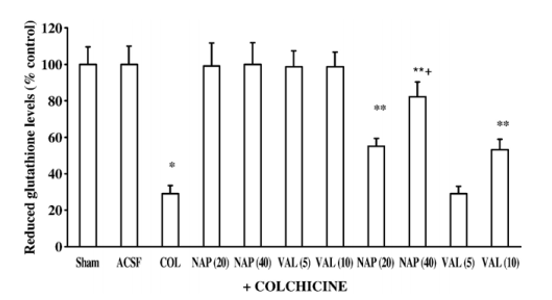 Figure. 4. Effect of cyclooxygenase inhibitors (naproxen (NAP) 20 and 40 mg/kg, p.o. and valdecoxib (VAL) 5 and 10 mg/kg, p.o.) on brain reduced glutathione levels in intracerebroventricular colchicine (COL)-injected rats. Values are mean ± S.E.M. * P<0.05 as compared to artificial cerebrospinal fluid (aCSF)- injected group; ** P<0.05 as compared to colchicine-injected group; **+ P<0.05 as compared to NAP (20) +COL group. (Repeated measures twoway ANOVA followed by Tukey's test for multiple comparisons). Note: aSCF = artificial cerebrospinal fluid, NAP = Naproxan, COL = Colchicine, VAL = Valdecoxib.
Figure. 4. Effect of cyclooxygenase inhibitors (naproxen (NAP) 20 and 40 mg/kg, p.o. and valdecoxib (VAL) 5 and 10 mg/kg, p.o.) on brain reduced glutathione levels in intracerebroventricular colchicine (COL)-injected rats. Values are mean ± S.E.M. * P<0.05 as compared to artificial cerebrospinal fluid (aCSF)- injected group; ** P<0.05 as compared to colchicine-injected group; **+ P<0.05 as compared to NAP (20) +COL group. (Repeated measures twoway ANOVA followed by Tukey's test for multiple comparisons). Note: aSCF = artificial cerebrospinal fluid, NAP = Naproxan, COL = Colchicine, VAL = Valdecoxib.
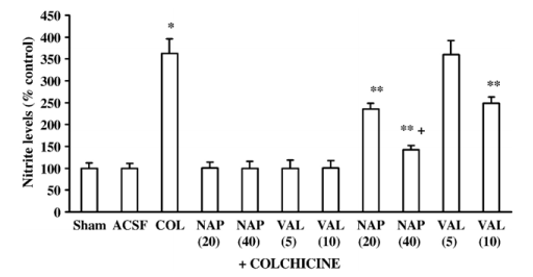 Figure. 5. Effect of cyclooxygenase inhibitors (naproxen (NAP) 20 and 40 mg/kg, p.o. and valdecoxib (VAL) 5 and 10 mg/kg, p.o.) on brain nitrite levels in intracerebroventricular colchicine (COL)-injected rats. Values are mean ± S.E. M. * P<0.05 as compared to artificial cerebrospinal fluid (aCSF)-injected group; ** P<0.05 as compared to colchicine-injected group; **+ P<0.05 as compared to NAP (20) +COL group. (Repeated measures two-way ANOVA followed by Tukey's test for multiple comparisons). Note: aSCF = artificial cerebrospinal fluid, NAP = Naproxan, COL = Colchicine, VAL = Valdecoxib.
Figure. 5. Effect of cyclooxygenase inhibitors (naproxen (NAP) 20 and 40 mg/kg, p.o. and valdecoxib (VAL) 5 and 10 mg/kg, p.o.) on brain nitrite levels in intracerebroventricular colchicine (COL)-injected rats. Values are mean ± S.E. M. * P<0.05 as compared to artificial cerebrospinal fluid (aCSF)-injected group; ** P<0.05 as compared to colchicine-injected group; **+ P<0.05 as compared to NAP (20) +COL group. (Repeated measures two-way ANOVA followed by Tukey's test for multiple comparisons). Note: aSCF = artificial cerebrospinal fluid, NAP = Naproxan, COL = Colchicine, VAL = Valdecoxib.
Quotation and ordering
If you have any special needs or questions regarding our services, please feel free to contact us. We look forward to cooperating with you in the future.
Reference
- Kumar A et al. Differential effects of cyclooxygenase inhibitors on intracerebroventricular colchicine-induced dysfunction and oxidative stress in rats[J]. European Journal of Pharmacology, 2006, 551(1-3):58-66.